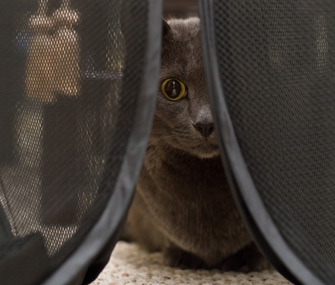Pain Management for Cats
Published on May 07, 2012

Cats tend to hide their pain, but if you know what to look for, you may be able to tell if your cat is hurt or injured.
Signs Your Cat Is in Pain
Cats in pain may:
- Hide
- Sit hunched up without moving
- Have little interest in people, other cats, activities or eating
- Groom less often or concentrate their grooming in one painful area
- Purr
- Vocalize
- Become restless
- Become aggressive
- Soil in the house
However, some painful cats don't exhibit obvious signs, or may just seem less active or not quite themselves.
Managing Your Cat's Pain
Not only do we wish to reduce pain for the sake of the cat's comfort but also because pain slows healing, interferes with immune function, and reduces appetite, all of which can place the cat in a further debilitated state.
It is far more effective to prevent pain than it is to reduce it once it appears, which is one reason many veterinarians give pain medication before surgery rather than waiting until the cat awakens. Before any surgery, ask your veterinarian how pain will be addressed. In the old days, veterinarians declined to give pain medication because they thought if the animal didn't feel pain, the cat would be too active and possibly tear out the sutures while playing. This is no longer the accepted procedure, and you should ask that your cat receive appropriate pain medication before any painful surgery.
When it comes to pain medication, cats are not little dogs. And they are certainly not little people. You cannot give your cat a smaller dose of the same medication you would take yourself or give to your dog, because in many cases, the medication would prove deadly to your cat. This is in part because the cat's liver does not have the same enzyme pathway that the human or dog liver has, so cats metabolize certain drugs differently.
Because of this, many nonsteroidal anti-inflammatory drugs (NSAIDs) can be dangerous to cats even at low doses. Many of these drugs cause ulceration of the gastrointestinal tract, kidney damage or liver damage in cats. Signs of toxicity may include abdominal pain, white gums, blood or digested blood (which looks black and tarry) in the stools, vomiting, lethargy, incoordination and stupor. If you notice any of these symptoms, your cat should be rushed to the veterinarian, who can provide more advanced treatment.
Opioid drugs can be safe and effective but can also cause side effects. When given at appropriate dosages under the supervision of a veterinarian, they can be used with confidence.
For localized pain, your veterinarian may be able to inject a local anesthetic. For chronic pain, such as that of arthritis, massage therapy, application of heat (being careful to avoid accidental burning), physical rehabilitation, and medication specific for pain relief can help many cats. Joint supplements formulated for cats can also be beneficial — just make sure the formulation is safe for cats. Your veterinarian can recommend the right products for your cat. Acupuncture has also been credited with pain relief in many instances.
At home, provide a soft warm bed placed where the cat doesn't have to jump to get to or from it. Also place the litterbox, food bowls and water bowls where the cat need not jump to get to them. Be aware that litterboxes with high sides can be difficult for the cat to get in and out of, and stairs can be uncomfortable to go up or down.
Although pain medication must be used with caution in cats, don't let fear of side effects prevent you from giving your cat the pain relief he needs. Just make sure you relieve his pain safely and under the advice of your veterinarian.





